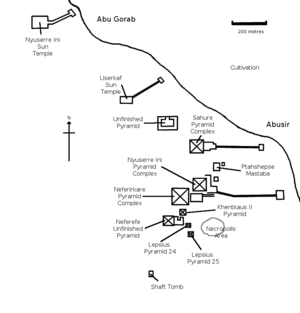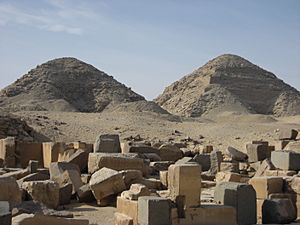Abusir facts for kids
| Location | Egypt |
|---|---|
| Region | Giza Governorate |
| Coordinates | 29°54′N 31°12′E / 29.9°N 31.2°E |
| Criteria: | Cultural: (i)(iii)(vi) |
| Designated: | 1979 (3rd session) |
| Part of: | Memphis and its Necropolis – the Pyramid Fields from Giza to Dahshur |
| Reference #: | 86-002 |
Abusir is an ancient Egyptian site. It is famous for its pyramid complex. This complex includes the ruins of four kings' pyramids. They date back to the Old Kingdom period.
Abusir is part of the Pyramid Fields. This area is a World Heritage Site recognized by UNESCO. The site is named after a nearby village. It is located on a desert plateau in Egypt. The Giza Pyramids are to its north. Saqqara is to its south. Abusir was a main burial ground for the ancient capital city of Memphis.
During the 5th Dynasty of the Old Kingdom, Abusir became very important. The nearby Giza area was already full of huge pyramids. So, the pharaohs of the 5th Dynasty chose Abusir for their own tombs.
Abusir is also where many ancient Egyptian papers, called papyri, were found. These papers are records from the temples. They tell us about the daily life and rules of the time. Experts from the Czech expedition have found many of these papyri. They help us learn about kings like Neferirkare Kakai and Neferefre. They also found papyri about Queen Khentkaus II.
Archaeologists from the Czech Institute of Egyptology have been working at Abusir since 1960. They continue to discover new things there.
Contents
Ancient Burial Ground
The earliest tombs at Abusir date back to the First Dynasty. These ancient burial sites show how people were buried long ago.
Abusir was the main royal burial ground during the Fifth Dynasty. There are four pyramids built for kings here. The pyramids at Abusir are not as grand as those from the Fourth Dynasty. They are smaller and made from local stone. This might show that the kings had less power or money then.
Most of the big pyramids at Abusir were first built as step pyramids. The largest one, the Pyramid of Neferirkare, was later changed. Its steps were filled in to make it look like a "true" pyramid.
Main Pyramids
The three most important royal pyramids at Abusir are:
- The Pyramid of Sahure. This is the oldest one. It is known for its beautiful carvings.
- The Pyramid of Neferirkare Kakai. This is the tallest pyramid at the site.
- The Pyramid of Niuserre. This pyramid is the most complete one still standing.
There are also two royal pyramids that were never finished:
- The incomplete Pyramid of Neferefre.
- The unfinished pyramid of Shepseskare?
Smaller Pyramids
Other smaller pyramids found here include:
- The pyramid of Queen Khentkaus II. She was the wife of Neferirkare. She was also the mother of Neferefre and Niuserre.
- Lepsius Pyramid no. 24. This pyramid likely belonged to a queen.
- Lepsius Pyramid no. 25. This was probably another queen's pyramid from the Fifth Dynasty.
Tombs of Important People
Many important officials and royal family members were buried near their kings. Their tombs are called mastabas.
- The mastaba of Ptahshepses. He was a top official under King Nyuserre.
There is also a group of four mastabas called the "Nakthsare" cemetery. These tombs likely belong to people connected to King Raneferef.
- The mastaba of Prince Nakhtsare.
- The mastaba of "count" Kakaibaef.
- The mastaba of Queen Khentkaus III. She was likely a wife of Raneferef.
- The mastaba of an unknown person, AS 31.
Abusir South Burials
South of the main pyramid area, there is another cemetery. It holds tombs of officials from earlier periods.
- The tomb of Ity (early Fourth Dynasty).
- The tomb of Hetepi (a priest from the Third Dynasty).
- The tomb of Nyankhseshat (a royal property manager from the Fourth Dynasty).
- The tomb of Kaaper (an architect and priest from the Fifth Dynasty).
- The tomb of Rahotep (a priest from the Fifth Dynasty).
- The tomb of Fetekti (a priest from the Fifth Dynasty).
- The tomb of Qar and his sons (a top official from the Sixth Dynasty).
- The rock-cut tomb of Nakhtmin (charioteer) from the New Kingdom.
Later Tombs
On a small hill south of Neferefre's pyramid, there is a cemetery from a later period called the Saite period.
- The tomb of Udjahorresnet.
- The tomb of Iufaa.
- The tomb of Menekhibneko.
- The tomb of Padihor.
- Tomb R3.
An Ancient Temple
Archaeologists also found the remains of a large temple at Abusir. It might have been built by Ramses II. This temple was located near the cultivated land. It was made of limestone and mud bricks. The temple was likely used to worship sun gods like Ra and Amun. Colorful carvings and signs of Ramses II were found there.
Damage During Protests
During the 2011 Egyptian protests, some parts of Abusir were damaged by people looking for treasures. For example, a piece from the tomb of priest Rahotep was stolen. Store rooms were also broken into.
Climate
| Climate data for Abusir | |||||||||||||
|---|---|---|---|---|---|---|---|---|---|---|---|---|---|
| Month | Jan | Feb | Mar | Apr | May | Jun | Jul | Aug | Sep | Oct | Nov | Dec | Year |
| Mean daily maximum °C (°F) | 19.6 (67.3) |
21.2 (70.2) |
24.5 (76.1) |
29 (84) |
32.9 (91.2) |
35.3 (95.5) |
35.5 (95.9) |
35.2 (95.4) |
32.9 (91.2) |
30.7 (87.3) |
25.9 (78.6) |
21.4 (70.5) |
28.7 (83.6) |
| Daily mean °C (°F) | 13.5 (56.3) |
14.5 (58.1) |
17.5 (63.5) |
21.1 (70.0) |
24.8 (76.6) |
27.5 (81.5) |
28.4 (83.1) |
28.3 (82.9) |
26.2 (79.2) |
24.1 (75.4) |
19.8 (67.6) |
15.4 (59.7) |
21.8 (71.2) |
| Mean daily minimum °C (°F) | 7.4 (45.3) |
7.9 (46.2) |
10.6 (51.1) |
13.3 (55.9) |
16.8 (62.2) |
19.8 (67.6) |
21.3 (70.3) |
21.4 (70.5) |
19.5 (67.1) |
17.5 (63.5) |
13.7 (56.7) |
9.4 (48.9) |
14.9 (58.8) |
| Average precipitation mm (inches) | 4 (0.2) |
3 (0.1) |
2 (0.1) |
1 (0.0) |
0 (0) |
0 (0) |
0 (0) |
0 (0) |
0 (0) |
0 (0) |
2 (0.1) |
4 (0.2) |
16 (0.7) |
| Source: Climate-Data.org, altitude: 18m | |||||||||||||
Abusir has a hot desert climate. This means it is very dry and hot, like most of Egypt.
See also
- Memphite Necropolis
- List of ancient Egyptian towns and cities
- List of ancient Egyptian sites, including sites of temples
- Double Pyramid
- List of megalithic sites




